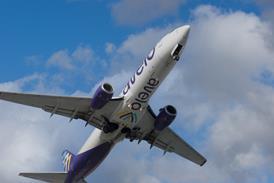The star of the static aircraft park at Asian Aerospace is one of the Republic of Singapore Air Force’s newest Lockheed Martin F-16D Block 52-plus Fighting Falcons. Similar in configuration to Greece’s latest F-16Ds and to Israel’s F-16Is, the aircraft is one of a batch of 20 F-16Ds ordered under the Peace Carvin IV programme in July 2000 and delivered from late 2003. The aircraft augment 20 earlier F-16Ds and 22 single-seat F-16Cs ordered under Peace Carvin II, III and IV, and eight F-16Ds and four F-16Cs leased for training use in the USA and subsequently purchased.
The Peace Carvin IV order was the first all-two seat order by Singapore, reflecting the RSAF’s increasing use of the F-16 in the air-to-ground role. The new aircraft are equipped with an extended fuselage spine accommodating an extensive electronic countermeasures suite, probably an Israeli SPS-3000 electronic warfare system. The aircraft also feature conformal fuel tanks on each side of the spine. These add 2,270 litres (600USgal) of fuel to the internal fuel load, and free up underwing hard points and pylons for additional weapons. The aircraft are almost identical to Israel’s F-16I Sufa (Storm) fighter bombers, with the same missile approach warning system and radar warning receiver antennas, and powered by the same Pratt & Whitney F100-229 engine.
The Israeli aircraft are fitted with Northrop Grumman’s AN/APG-68(V)9 multimode radar, with a 30% increase in detection range compared with the older APG-69. The Singaporean F-16D Block 52 plus aircraft may be similarly equipped.
These “Super Sixteens” match the Boeing F-15’s range, and are so capable that Israel chose to procure 102 F-16Is, cancelling further orders for the more expensive F-15I.
The RSAF F-16D at Asian Aerospace wears the hornet insignia of No.145 Squadron, the air force’s newest F-16 squadron, and is normally based at Changi (East) - Singapore's newest military airbase, which officially opened on 29 November 2004. It is the first RSAF base that was not previously a UK Royal Air Force station. Its position will allow its aircraft quicker and easier access to the vital training areas over the South China Sea.
Source: Flight Daily News























